Blog
How to Choose the Right AED for High-Risk Environments (Construction Sites and Manufacturing Facilities)
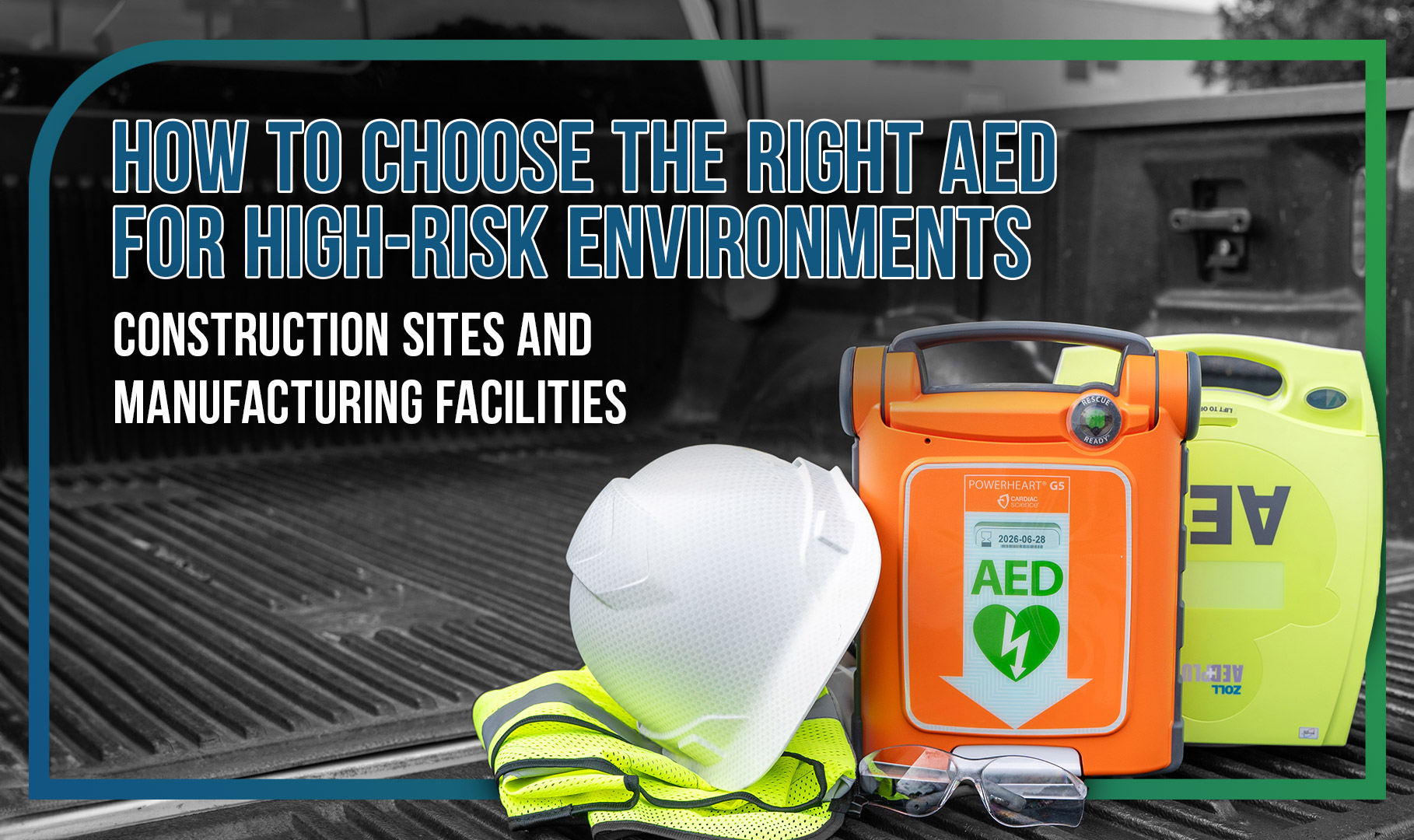
When it comes to workplace safety, one of the easiest investments you can make is having an Automated External Defibrillator (AED) on-site. For companies operating in high-risk environments like construction sites and manufacturing facilities, the need for life-saving equipment is even more critical. With the physical demands of the job, as well as physical activity and possible exposure to temperature extremes, sudden cardiac arrest (SCA) is constantly a concern. In fact, SCA can affect anyone, anywhere. Having an AED available can drastically increase your worker’s chances of survival.
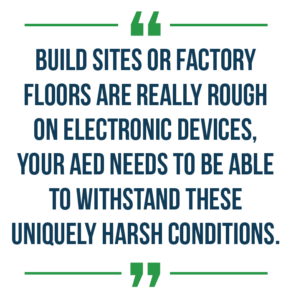 Build sites or factory floors are really rough on electronic devices, your AED needs to be able to withstand these uniquely harsh conditions. There are a few key features that you should look for before you buy an AED for one of these high-risk sites. Which is why the Powerheart G5 or ZOLL AED Plus are both great options for worksites unsuited for delicate equipment.
Build sites or factory floors are really rough on electronic devices, your AED needs to be able to withstand these uniquely harsh conditions. There are a few key features that you should look for before you buy an AED for one of these high-risk sites. Which is why the Powerheart G5 or ZOLL AED Plus are both great options for worksites unsuited for delicate equipment.
AEDs Are Essential in Construction and Manufacturing Environments
Construction sites and manufacturing facilities have higher-than-average risks when it comes to workplace injuries. The physical demands, operating heavy machinery, particulate in the air, and temperature change all play a role in increasing the likelihood of a cardiac emergency. Here are just a few reasons why AEDs are crucial in these settings:
- Physical Stress: Lifting heavy materials, working long hours, and physical exertion can put stress on the heart and trigger cardiac events, especially for workers who may have underlying health conditions.
- Hazardous Environments: From exposure to extreme temperatures to noisy machinery and confined spaces, construction and factory workers often work in conditions that increase the risk of heart issues.
- Accidents and Injuries: Workers are more likely to be involved in accidents that can lead to emergencies, including heart-related events. In fact, workplace injuries or trauma can increase the likelihood of sudden cardiac arrest.
Because every second counts when it comes to responding to SCA, having an AED on-site can make the difference between life and death. However, an AED will do your employees no good in an emergency if it breaks from the wear and tear of these rugged environments. It needs to be tough, reliable, and easy to use even under pressure.
Key Features for an AED in High-Risk Environments
When selecting an AED for rugged environments, you want to make sure it’s suited to the challenges these environments present. Here’s what to look for:
1. Durability and Toughness
The construction industry is full of dust, dirt, vibrations, and extreme temperatures. Manufacturing facilities often have noisy machinery, high foot traffic, and a greater risk of accidental damage. The AED must be able to handle these tough conditions. Look for an AED that is rugged, shock-resistant, and weatherproof—one that can withstand rough handling, whether it’s dropped, exposed to moisture, or left in a hot or cold environment.
2. Ease of Use
In high-pressure situations, you need an AED that can be operated quickly and easily. The ideal AED should have clear, voice-guided prompts that walk even a non-medical person through the steps. In an emergency, time is of the essence, so the simpler the better.
3. Automatic Functionality
In high-stress situations, you don’t want to rely on a person’s ability to correctly assess the situation. AEDs with automatic shock delivery are ideal in these environments. The AED should automatically analyze the victim’s heart rhythm and deliver a shock if necessary, without requiring manual intervention. This helps ensure that the right action is taken quickly, even by someone with limited medical training.
4. Maintenance and Reliability
With the heavy-duty nature of construction and manufacturing sites, you need an AED that’s low maintenance and always ready to go. Look for AEDs that perform self-checks to ensure they’re in working order, and have long-lasting batteries and pads that are easy to replace.
Why the Powerheart G5 and ZOLL AED Plus Are Great Choices
Now that we know what features to look for, let’s dive into two AEDs that check all the boxes for high-risk environments: the Powerheart G5 and the ZOLL AED Plus. Both are top-rated devices that are built for tough environments and easy-to-use, ensuring that your team is always prepared in case of a sudden cardiac arrest.
Powerheart G5 AED
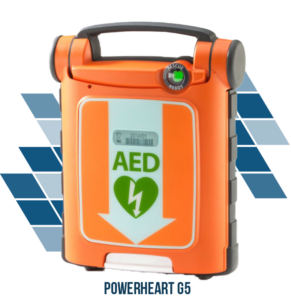 The Powerheart G5 is an excellent choice for construction and manufacturing environments because it is built to be rugged and reliable. Here’s why it’s perfect for these high-risk settings:
The Powerheart G5 is an excellent choice for construction and manufacturing environments because it is built to be rugged and reliable. Here’s why it’s perfect for these high-risk settings:
- Durability: The Powerheart G5 is designed to handle tough conditions. It’s IP55-rated, meaning it’s dust and water-resistant, and can withstand harsh environments. Whether it’s the dust and dirt of a build site or the humidity of a factory floor, the G5 is built to perform.
- Automatic Shock Delivery: This AED is fully automated. It will analyze the heart rhythm and deliver a shock if needed, without requiring manual intervention, which speeds up response time during emergencies.
- Real-Time CPR Coaching: The Powerheart G5 gives real-time feedback on chest compressions, helping to guide users to perform the correct depth and speed of compressions, even if they don’t have formal CPR training.
- Ease of Use: With clear voice prompts and visual indicators, anyone on the site can use the Powerheart G5 in an emergency. Plus, the device performs self-checks to ensure it’s always ready for use.
ZOLL AED Plus
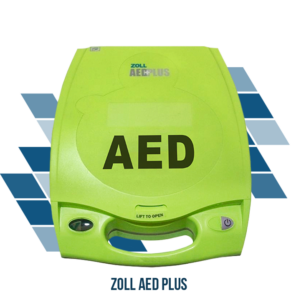 The ZOLL AED Plus is another great option for high-risk environments, known for its user-friendly design and advanced features:
The ZOLL AED Plus is another great option for high-risk environments, known for its user-friendly design and advanced features:
- Durability: The ZOLL AED Plus is designed for tough environments. The AED Plus is IP55-rated, meaning it’s resistant to dust and moisture, and is built to endure the rough handling and wear-and-tear common in construction and manufacturing sites.
- Real-Time CPR Feedback: Just like the Powerheart G5, the ZOLL AED Plus provides real-time CPR feedback, guiding the user to deliver high-quality compressions. This feature is particularly valuable on build sites or factory floors where workers might not be trained in CPR.
- Easy to Use: The ZOLL AED Plus is designed to be as intuitive as possible. It features clear voice prompts that provide step-by-step instructions, and the device is capable of automatic shock delivery for ease of use during emergencies.
- Built-In Intelligence: The ZOLL AED Plus can automatically adjust its prompts based on the situation, ensuring that the device is always giving the right guidance in an emergency.
When it comes to choosing an AED for construction sites or manufacturing facilities, you need equipment that is tough, reliable, and easy to use. Both the Powerheart G5 and ZOLL AED Plus meet these criteria, with features designed to help save lives in high-risk environments. These AEDs will 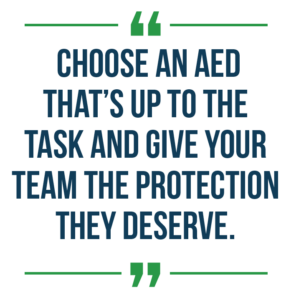 not only help you meet safety regulations but also provide your team with the confidence that they’re prepared for any emergency. For a more comprehensive breakdown of choosing an AED for your workplace, check out our AED buying guide for workplaces.
not only help you meet safety regulations but also provide your team with the confidence that they’re prepared for any emergency. For a more comprehensive breakdown of choosing an AED for your workplace, check out our AED buying guide for workplaces.
If you’re ready to take action, both of these devices are excellent choices that will give your employees the best chance of survival in the event of sudden cardiac arrest. After all, safety isn’t just about preventing accidents—it’s about being prepared for the unexpected. Choose an AED that’s up to the task and give your team the protection they deserve.
